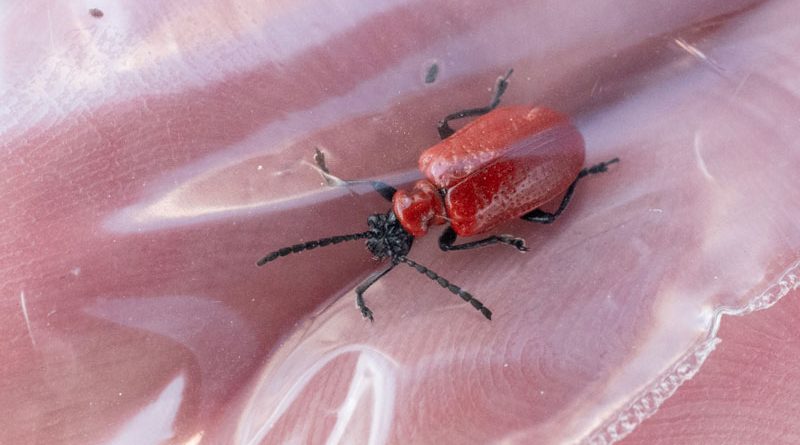Lily beetles frustrate gardeners

Sean Feagan Photo
For resident green thumbs with ornamental lilies, there is a non-native nemesis making a big impact on their precious plants: the scarlet lily beetle (Lilioceris lilii).
These small insects, introduced to Canada from Europe, feed on native and cultivated lilies (Lilium species) and Fritillaria, often impacting the plant’s health and vigour. They have also been found on Hosta, lily of the valley and Solomon’s seal (Polygonatum species) but impact them less. Daylilies (Hemerocallis species) are not targeted by the beetle.
The beetles are a new nuisance for Strathmore resident Trish Romanchuk, who planted fewer lilies this year in response to them. “This year we started having an issue with them, and they’ve decimated one of my plants already,” she said. “They’re problematic and they are quick to spread.”
These bright-red, spotless (unlike ladybugs) beetles overwinter in the soil and emerge each spring when the weather warms. They then feed, mate and lay eggs on growing lilies. Eggs are laid in strings along the undersides of leaves, with a single female laying 200 to 300 eggs. The larvae, which have the endearing habit of covering themselves in their own excrement to deter predators, hatch after about eight to 10 days, then rapidly feed on the host plant. The larvae have four stages, and ultimately form a cocoon from which adults emerge in mid-summer.
In North America, scarlet lily beetles were first identified in Montreal in the 1940s, likely from imported lily bulbs, and then spread across the continent, explained Dan Johnson, an entomology professor at the University of Lethbridge.
“There’s been minor outbreaks in the eastern U.S. and eastern Canada, then they worked their way across the prairies,” he said. “People think they’re brand new, but they actually showed up here (in Alberta) around 2001 or 2002, but they didn’t really spread very much at first.” The beetle is now found in every province except for British Columbia.
The beetles have been expanding across Alberta in greater numbers over the last five years, he said. While the reason for this trend is unknown, their establishment has been helped by a lack of predators.
“The tragedy is that they didn’t bring their natural enemies with them – they have no natural predators in North America,” he said. “That’s a repeated story over and over – a lot of invasive species come and they leave their natural controls behind.”
Efforts are ongoing to introduce predators of the beetles from Europe to help control their populations and spread. “The hope for the future is there’s a number of parasitoids (predatory wasps that lay their eggs in the living bodies of host larvae), and one of them is particularly good at killing the beetle,” said Johnson.
This species, called Tetrastichus setifer, has been released from multiple sites in Alberta and has the potential to overwinter and establish here. “It’s been released, and if it takes off, with a little bit of encouragement, it can do a good job,” he said.
In the meantime, there are a few things that gardeners can do to beat the beetles, he said. One of the best and easiest ways is simply removing them by hand.
“It sounds a little unexciting, but picking is probably the best thing you can do,” said Johnson. “If poopy-looking insects bother people, they can just put on a glove.”
Squishing the beetle larvae without a glove is a mistake made only once, said Romanchuk.
Johnson advises putting any collected insects in a container with water with some soap (or cooking oil) to kill them. If the beetles are suspected but not visible, they can sometimes be found in the soil. The use of less-toxic pest control agents, such as diatomaceous earth deployed at the plant’s base, or neem oil, are other possible control approaches, but are costly and more labour intensive.
Johnson advises against using chemical insecticides to ward off the beetles, as too many beneficial species could be harmed inadvertently. “Spraying is a tragedy because lilies really attract a lot of pollinators and those pollinators would be killed,” said Johnson. “You don’t want to kill the bees and butterflies.”
Sightings of lily beetles can be reported via email to the Alberta Regional Lily Society (lilybeetle@arls-lilies.org) and Olds College (lily_beetle@shaw.ca).
